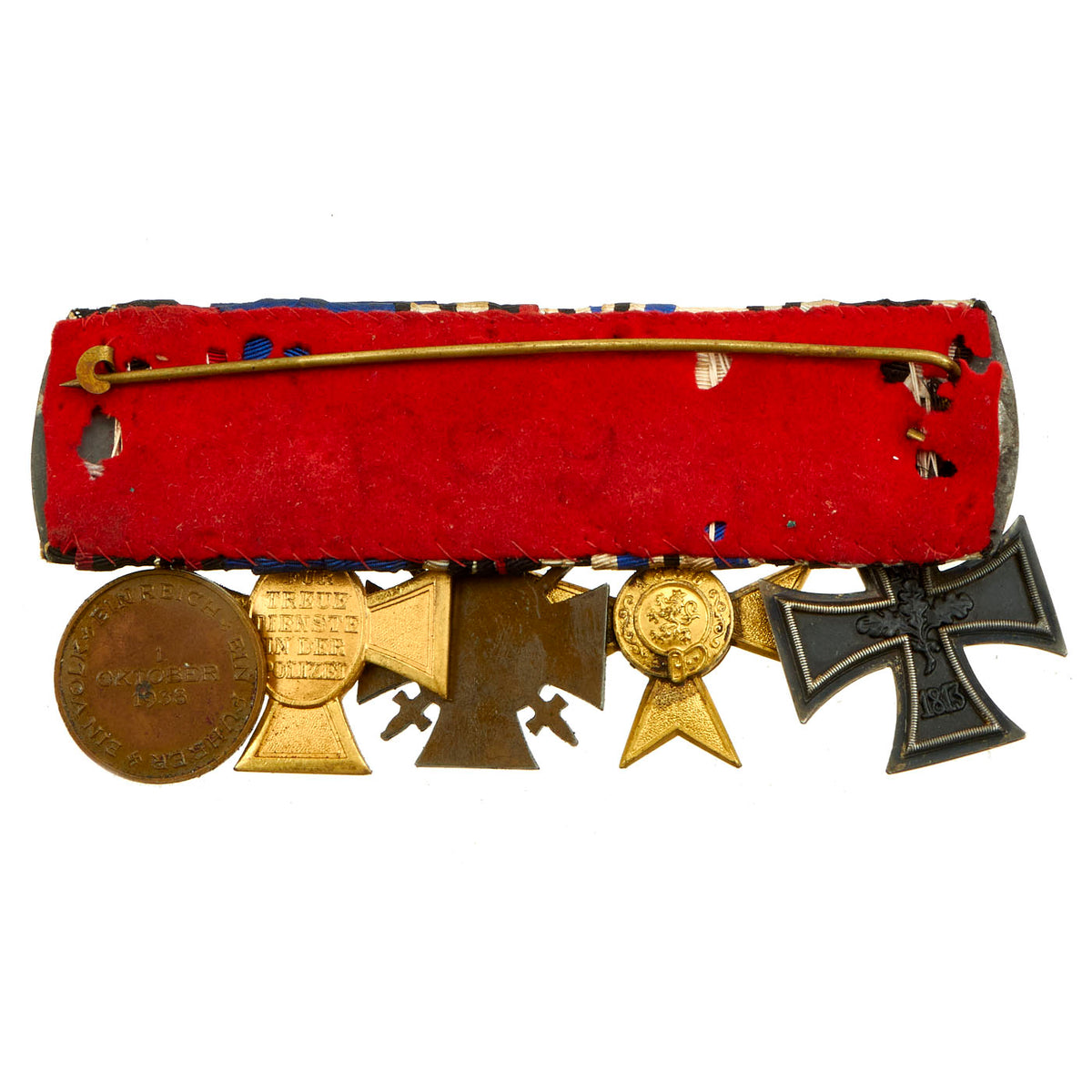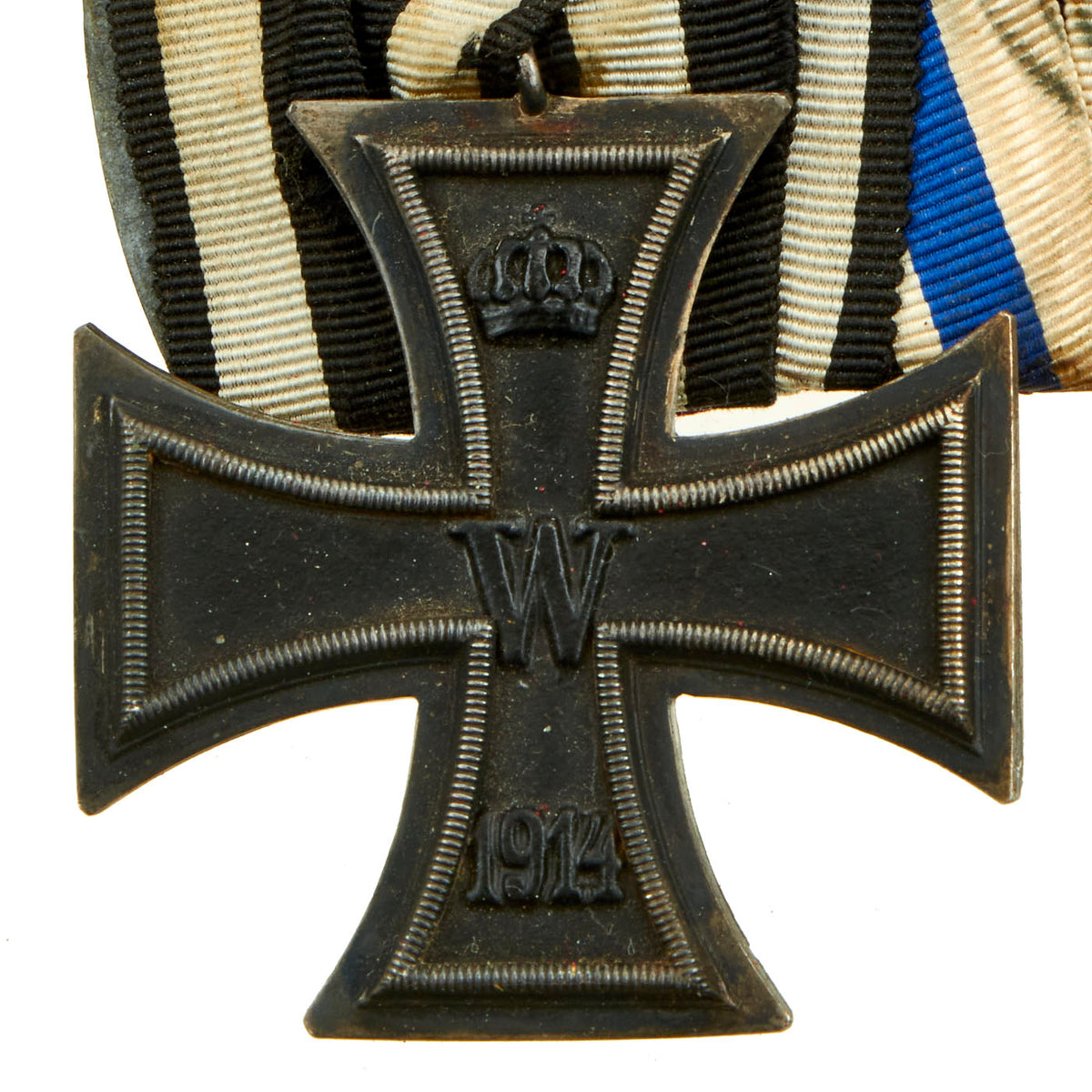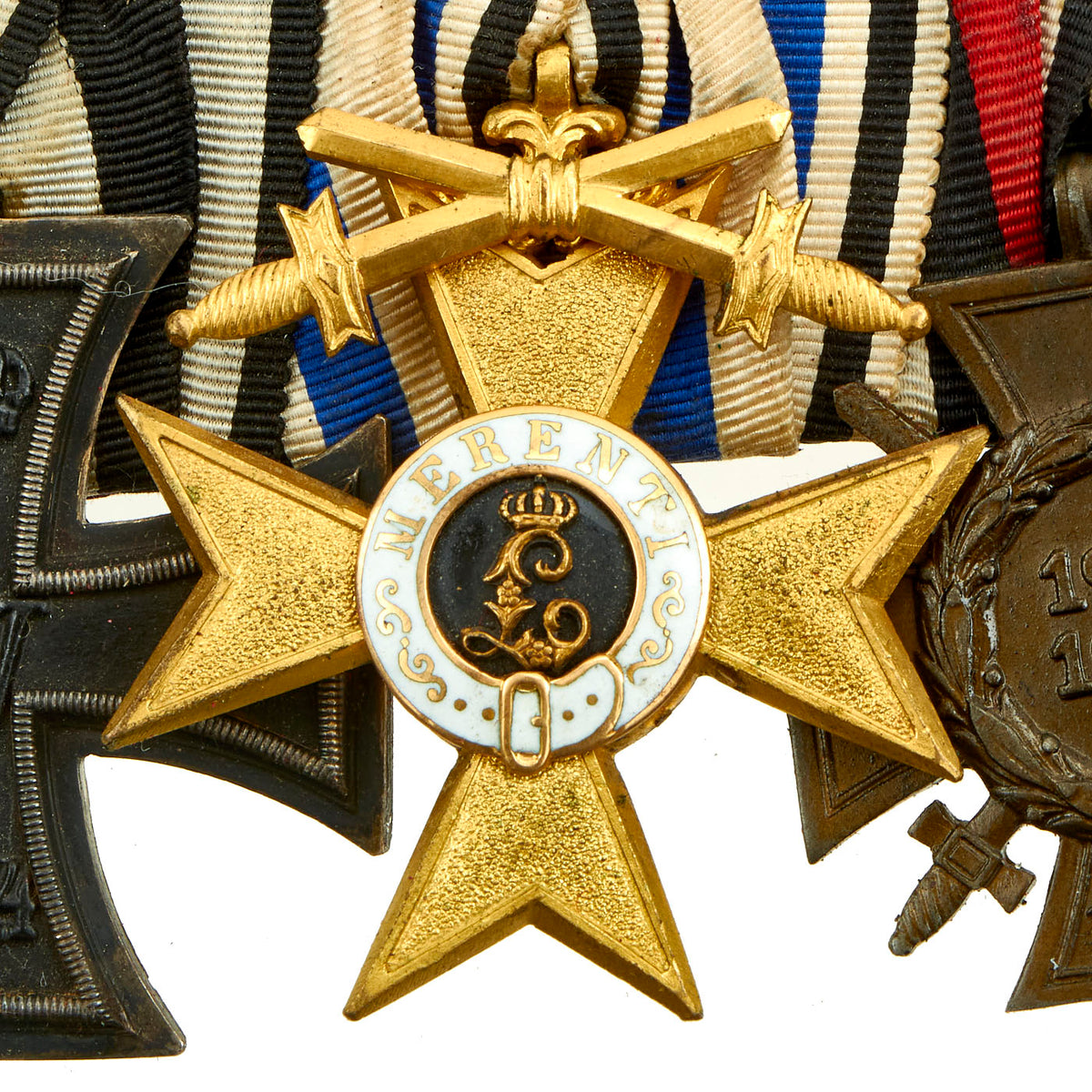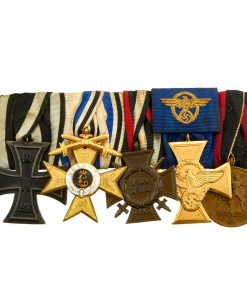Original German WWI & WWII Medal Bar Featuring Iron Cross 1914 2nd Class – 5 Total Medals Original Items
$ 395,00 $ 118,50
Original Items: Only One Available. This is a very nice German medal bar from a soldier who fought during WWI and WWII. Judging by the awards featured, he would have spent over 20 years in service within the German military.
The Following Medals Are Featured (From Left to Right):
– Imperial German WWI Iron Cross 1914 2nd Class Medal: Established by Frederick William in 1813 for gallantry in action, the decoration was revived several times for later conflicts. The bulk of the issues are divided into 1st and 2nd class versions, but a rare and superior ‘Grand Cross’ was also awarded for successful field commanders. During WW1 the lower decoration was freely awarded with 5½ million second class types issued.
– WWI Bavarian Military Merit Cross (Without Royal Crown): The Bavarian Military Merit Cross was that kingdom’s main decoration for bravery and military merit for enlisted soldiers. It was intended “to reward extraordinary merit by non-commissioned officers, soldiers, and lower-ranking officials.” It was originally established on July 19, 1866 as the 5th Class of the Military Merit Order, which was the main decoration for bravery and military merit for officers and higher-ranking officials. Civilians acting in support of the army were also made eligible for the decoration. The Military Merit Cross ranked after the Gold and Silver Military Merit Medals (renamed the Bravery Medals in 1918), which were Bavaria’s highest military honors for NCOs and enlisted soldiers. The cross was a Maltese cross with a center medallion. The obverse of the center medallion had an “L” cipher of King Ludwig II in the center and the word “MERENTI” on the ring. The reverse had a Bavarian lion with the date of founding, “1866”, on the ring. The center medallion was enameled (the original Military Merit Cross was distinguished from the Knight 2nd Class of the Military Merit Order only by having silver instead of blue enameled arms).
– Hindenburg Cross with Crossed Swords (for combat): The Honor Cross of the World War 1914/1918 (German: Das Ehrenkreuz des Weltkriegs 1914/1918), commonly, but incorrectly, known as the Hindenburg Cross was established by Field Marshal Paul von Hindenburg, President of the German Republic, by an order dated 13 July 1934, to commemorate the distinguished deeds of the German people during the First World War. This was Germany’s first official service medal for soldiers of Imperial Germany who had taken part in the war, and where they had since died it was also awarded to their surviving next-of-kin. Shortly after its issuance, the government of NSDAP Germany declared the award as the only official service decoration of the First World War and further forbade the continued wearing of German Free Corps awards on any military or paramilitary uniform of a state or NSDAP Party organization.
– NSDAP Police Long Service Award (25 Year): The Police Long Service Award was a long service medal awarded to active members of the German Police during the era of NSDAP Germany as a political award. Professor Richard Klein designed the awards, which varied slightly in design depending on the length of service of the recipient. On 30 January 1938, Adolf H ordered the institution of an award for members of the police force who met qualifications based on length of service. The award was given in three grades to men who had served for eight, eighteen, and twenty-five years. The design of all three medals had the police insignia, which consisted of a national eagle emblem surrounded by a wreath, on the obverse side. All three awards were emblazoned with the inscription Für treue Dienste in der Polizei (“For faithful service in the Police”) on the reverse. On 12 August 1944, a higher grade was authorized for 40 years of service. It was to be in the form of a gold metal bar with the number 40 with oak leaves, to be affixed onto the ribbon of twenty-five years award. There is no record of it being awarded prior to the end of World War II in Europe. To qualify for the medal, a person had to be an active member of the police or “an administrator” in the police service. Military service time could also be applied to the total time of service needed for the award.
– 1 October 1938 Commemorative Sudetenland Medal: German Pre-WWII 1 October 1938 Commemorative Medal (Die Medaille zur Erinnerung an den 1. Oktober 1938), commonly known as the Sudetenland Medal or Czech Conquest Medal. This was a decoration of NSDAP Germany awarded in the interwar period. Instituted on 18 October 1938, the medal was awarded to German military personnel who participated in the occupation of Sudetenland and the occupation of Czechoslovakia in March 1939. The medal was awarded to all German (and as well Sudeten) State officials and members of the German Wehrmacht and SS who marched into Sudetenland. Later it was awarded to military personnel participating in the occupation of the remnants of Czechoslovakia on 15 March 1939. It was awarded until 31 December 1940. In all 1,162,617 medals and 134,563 bars were awarded.
The medal was similar in appearance as the Anschluss Medal, the reverse only differed in the date. It was designed by Professor Richard Klein. It is round and of the obverse there is a man standing of a podium with the Third Reich coat of arms and holding the NSDAP flag, he holding the hand and helping him get on the podium of another man who had a broken shackle on his right hand, this symbolize the joining to the Reich of Austria. On the reverse side is the inscription “1. Oktober 1938” (1 October 1938). The date is surrounded with the words “Ein Volk, Ein Reich, Ein Führer” (One People, One Empire, One Leader).
The medal was dye-struck and high in detail, with a bronze finish. The medal was suspended from a black ribbon with a red stripe in the middle, these being the colors of the Sudetenland.
This is a wonderful example of a WWI Imperial German medal bar from a soldier whose service carried on up until the start of WWII and more than likely into WWII.
Comes more than ready for display!
Fast Shipping with Professional Packaging
Thanks to our longstanding association with UPS FedEx DHL, and other major international carriers, we are able to provide a range of shipping options. Our warehouse staff is expertly trained and will wrap your products according to our exact and precise specifications. Prior to shipping, your goods will be thoroughly examined and securely secured. We ship to thousands clients each day across multiple countries. This shows how we're dedicated to be the largest retailer on the internet. Warehouses and distribution centres can be located throughout Europe as well as the USA.
Note: Orders with more than one item will be assigned a processing date depending on the item.
Before shipping before shipping, we'll conduct a thorough inspection of the items you have ordered. Today, the majority of orders will be delivered within 48 hours. The delivery time will be between 3-7 days.
Returns
The stock is dynamic and we cannot completely manage it because multiple stakeholders are involved, including our factory and warehouse. So the actual stock may alter at any time. It's possible that you may not receive your order once the order has been made.
Our policy is valid for a period of 30 days. If you don't receive the product within 30 days, we are not able to issue a refund or an exchange.
You can only return an item if it is unused and in the same state as the day you received it. You must have the item in its original packaging.
Related products
Uncategorized
Uncategorized
Uncategorized
Uncategorized
Uncategorized
Band of Brothers ORIGINAL GERMAN WWII Le. F.H. 18 10.5cm ARTILLERY PIECE Original Items
Uncategorized
Uncategorized
Uncategorized
Uncategorized
Uncategorized
Uncategorized
Uncategorized
Uncategorized
Angolan Rebel 1970s era 60mm Inert Display Mortar from Angolan Civil War Original Items
Uncategorized
Uncategorized
Uncategorized
Uncategorized
Uncategorized
Uncategorized
Uncategorized
Armoured Fighting Vehicles of the World: AFVs of World War One (Hardcover Book) New Made Items
Uncategorized












































































